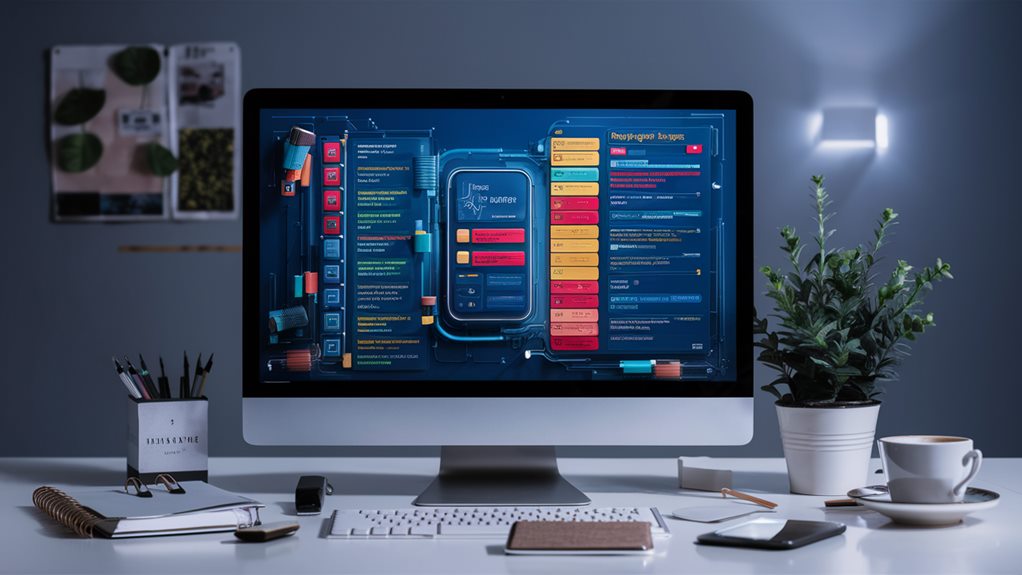To organize tasks and prioritize effectively, start with the Eisenhower Matrix to identify urgent and important tasks. Next, apply the Pomodoro Technique by breaking your work into focused, 25-minute segments, ensuring regular breaks to maintain energy. Use the ABCDE Method to categorize tasks based on their importance, delegating where possible. Leverage digital task management tools to streamline your workflow and track your progress. Finally, set SMART goals to make your tasks specific, measurable, and achievable. These strategies will transform your productivity, and you might find even more insights waiting just a step ahead.
Key Takeaways
- Use the Eisenhower Matrix to categorize tasks by urgency and importance, ensuring focus on what truly matters.
- Implement the Pomodoro Technique to enhance productivity by working in focused intervals followed by short breaks.
- Apply the ABCDE Method for prioritization, clearly labeling tasks to determine what requires immediate attention versus what can be delegated or eliminated.
- Utilize digital task management tools to streamline workflow, automate tasks, and track progress efficiently.
- Set SMART goals to provide clarity and direction, ensuring your tasks align with broader objectives while remaining achievable and measurable.
Use the Eisenhower Matrix

How do you decide what tasks deserve your attention first? The Eisenhower Matrix can be your go-to tool for effective time management and decision making. This simple framework helps you categorize tasks into four quadrants based on urgency and importance.
Start by listing your tasks. Then, place them in one of the four quadrants:
- Urgent and Important: Do these tasks now.
- Important but Not Urgent: Schedule these for later.
- Urgent but Not Important: Delegate these tasks if possible.
- Neither Urgent nor Important: Eliminate these from your to-do list.
By using this matrix, you can quickly identify what needs your immediate attention and what can wait. This clarity not only boosts your productivity but also minimizes stress.
You'll find that focusing on what truly matters helps streamline your efforts, making your decision making more effective.
Implement the Pomodoro Technique

When you're struggling to stay focused, the Pomodoro Technique can be a game-changer. This time management method breaks your work into manageable intervals, typically 25 minutes, followed by a short break. By using this approach, you can enhance your concentration and productivity, similar to how mini drones with cameras improve aerial photography by allowing users to capture stunning images with ease and clarity through features like camera quality and performance.
Here's how to implement it effectively:
- Set a timer for 25 minutes: Choose a task and commit to working on it without interruption.
- Work until the timer goes off: Stay focused solely on the task at hand, resisting distractions.
- Take a 5-minute break: Once the timer rings, step away from your work. Use this time to stretch, grab a snack, or clear your mind.
- Repeat: After four Pomodoros, take a longer break (15-30 minutes) to recharge.
Prioritize With ABCDE Method

The ABCDE Method is a powerful tool for prioritizing your tasks effectively. It helps you categorize tasks based on their importance, ensuring you're focused on what truly matters. Here's how it works:
- A: Must do (urgent and important)
- B: Should do (important but not urgent)
- C: Nice to do (neither urgent nor important)
- D: Delegate (tasks that can be done by others)
- E: Eliminate (tasks that don't add value)
To implement this method, combine it with time blocking and task batching. This allows you to set specific times for each category, maximizing your productivity.
| Priority | Task Description | Time Block (mins) |
|---|---|---|
| A | Submit project report | 60 |
| B | Prepare presentation | 45 |
| C | Respond to emails | 30 |
| D | Delegate social media | 15 |
| E | Cancel unnecessary meetings | 10 |
Leverage Digital Task Management Tools

To maximize the effectiveness of the ABCDE Method, consider leveraging digital task management tools. These tools can streamline your workflow, enhance organization, and help you stay on track with your priorities. By incorporating features like task automation and time tracking, you can enhance your productivity significantly. For instance, just as the best raised garden bed kits can elevate your gardening experience, digital tools can transform your task management efficiency.
Here are some key benefits of using digital task management tools:
- Task Automation: Automate repetitive tasks, freeing up your time for more important activities.
- Time Tracking: Keep track of how long you spend on each task, allowing you to identify areas for improvement.
- Progress Monitoring: Gain insights into your task completion rates and adjust priorities as needed.
- Collaboration Features: Easily share tasks and collaborate with team members, ensuring everyone stays aligned.
Set SMART Goals

Setting SMART goals is fundamental for achieving clarity and direction in your task management process. SMART stands for Specific, Measurable, Achievable, Relevant, and Time-bound. By setting goals that meet these criteria, you enhance your time management skills and guarantee you stay focused on what truly matters.
For instance, just as selecting the right resistance bands can customize your fitness journey, specific goals can customize your productivity efforts.
Start with specificity. Instead of saying, "I want to improve my skills," specify what skill you want to enhance and how.
Next, make your goal measurable. This allows you to track progress and stay motivated. For example, "I'll complete three online courses in six months" is measurable.
Ensure your goals are attainable. Set challenging yet realistic targets. It's better to aim for something you can achieve rather than something that's too ambitious.
Relevance is vital; your goals should align with your broader objectives. Finally, make your goals time-bound. Setting deadlines creates a sense of urgency, driving you to act.
Frequently Asked Questions
How Can I Improve My Focus While Organizing Tasks?
To improve your focus while organizing tasks, start by managing your time effectively. Break your work into smaller, manageable chunks and set specific deadlines. Use distraction control techniques, like turning off notifications and creating a dedicated workspace.
Prioritize your tasks based on urgency and importance, and tackle the most challenging ones when your energy levels are high. Regular breaks can also help maintain your concentration, so don't forget to recharge throughout the day.
What Are Common Mistakes in Task Prioritization?
You often make common mistakes in task prioritization, like underestimating how long tasks will take, which disrupts your time management. You might also let procrastination habits take over, pushing important tasks down the list. Failing to take deadlines and urgency into account can lead to last-minute chaos.
To improve, regularly reassess your priorities and set realistic timelines. Break tasks into smaller steps to avoid feeling overwhelmed and keep your focus sharp.
How Often Should I Review My Task List?
You might think reviewing your task list too often is a waste of time, but it's essential for maintaining task list efficiency. Aim to review your task list daily or weekly, depending on your workload. Set task list reminders to stay on track.
Regular task list updates help you prioritize effectively, ensuring you tackle the most important items. This frequency keeps you organized and focused, preventing overwhelming clutter from building up.
Can I Adapt These Methods for Team Projects?
Absolutely, you can adapt these methods for team projects. Focus on team collaboration by establishing clear goals and deadlines. Delegate tasks based on each member's strengths to enhance project management. Regularly check in to guarantee team communication stays strong, addressing any issues promptly. Encourage feedback to refine your approach and keep everyone aligned. By implementing these strategies, you'll create a more efficient and productive team environment that drives project success.
What Should I Do if I Miss a Deadline?
If you miss a deadline, don't panic. First, assess the deadline consequences; communicate with your team to explain the situation.
Next, implement recovery strategies like prioritizing the most critical tasks and reallocating resources. Break your work into manageable parts and set mini-deadlines to regain momentum.
Conclusion
By implementing these five methods, you can transform how you tackle tasks and boost your productivity. For instance, imagine a marketing manager juggling multiple campaigns. By using the Eisenhower Matrix to identify urgent tasks and the Pomodoro Technique to maintain focus, they increased their output dramatically. You don't have to feel overwhelmed; start applying these strategies today and watch your efficiency soar! Take control of your workload and make every minute count.

